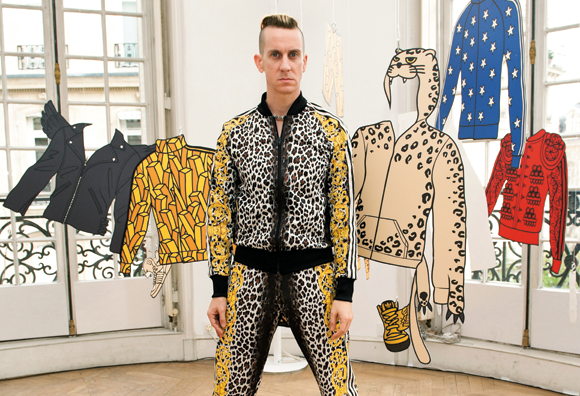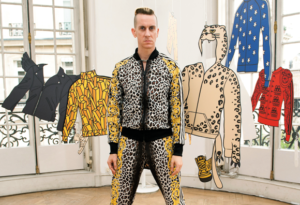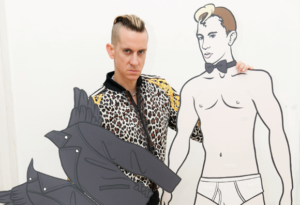What should you expect when meeting a designer who creates clothes as wild, loud and exuberant as the Pop- and Hip Hop-Stars sporting them? Whose Twitter-feed draws attention to itself in capital letters only, who most of the time looks grim on pictures and is known for being very focused on his goal from a very early age on. You might expect a personality mirroring his creations in every shade of gorgeous craziness, but the Jeremy Scott (in a leopard print track suit and LED bindi) who met with FAQ Magazine in his Parisian showroom was overwhelmingly calm, warm and ever so charming.
Let’s go back a bit. You grew up on a farm in Missouri.
Yes.
What were your first visual influences?
Television and the movies other than what would obviously surround you. I absorb all things. So of course as far as what was around me, a lot of nature and lots of … well, nature basically.
It’s not really obvious that you’re a nature-boy when you look at your designs.
No, absolutely not. But yeah, television, movies: there was a whole other world which seemed much more gla- morous.
The concepts for your first ever collections seemed rather dark and fuelled by destruction: the Chernobyl theme, crashes and rampages. Was there a sudden turn to the positive somewhere on the way?
I don’t think there was a turn really. Any artist goes through different phases, movements and shifts and you’re also influenced by what’s going on at that time either to go against it or be part of it. Whatever’s right at that mo- ment.
So you’re contradicting our times of hardship and crises now?
Perhaps, perhaps.
Bringing sunny sides …
Trying to, trying my best.
Is the dystopian doomsday designer bound to come back even- Is that why you turned down all those offers from big fashion tually? houses?
I don’t know if I was really that doom and gloom though. There was more the artistic bend to it.
Even with Chernobyl?
Well the collection was all-white. You didn’t see it, because it was never shown. It was all white, so not so gloomy.
But white’s pretty dark for you, isn’t it?
No.
Compared to now.
White’s always optimistic, that’s why wedding dresses are white.
Not in China for example.
Oh, really, it’s not?
It’s associated with death, you wear it at funerals.
So for 99% of the world, white’s a really optimistic colour [laughs].
With adidas, same as with your other collaborations it seems that you’re not really the guest designer but more like those companies are guest-manufacturing for you.
[laughs]
You’re brand is extending with them. Is it a condition to have absolute artistic freedom?
I’ve never thought about it like that. I always try to bring as much of my inspiration, love and purity of my design to everything I do and I have only worked with people that have only wanted that from me. So it’s not a dissimilation of me, it’s the purest form: THE, whatever the might be. The Perfume, not the Eau de Toilette. Everything I do is the Perfume, because I’m just purely me and I have a very strong personality and design aestethic. So maybe that’s why it comes across that way.
So there never was anyone trying to get you to do things differently, like talking you out of the wings for once?
No. And why would they? Because it’s always been successful.
[Protesting press agents: We love the wings!]
What’s not successful for me is when I don’t do things to the highest level of me, the most me. If I try to pull back, that’s when it’s not successful for anyone, not just me but for any kind of thing. The more, the better. The stronger, the better.
Is that why you turned down all those offers from big fashion houses?
Sure. Each would be a different reason why, to be honest. But mostly why I never decided to do another designer’s house is because I always wanted to explore the things I wanted to design and the world I was creating further. And so, back to what you were saying, the collaborations are a continuation of the world I’m creating. I’m not masquerading as something else – which has always been kind of the fear and the viewpoint of what it is to design for another house. It’s like you’re supposed to be that, because that’s where you’re at, and if you’re too much yourself, you’re doing you, and if you do too much of that, then why are you even there? So you’re kind of caught in the middle whereas with something like adidas I’m playing with the heritage of the brand, the iconography of the brand but I’m bringing all this new personality to it. And maybe that’s something I could do just as well at a house but maybe didn’t believe in doing before.
I was thinking about Karl Lagerfeld who mentioned you as, in his opinion, the only one suitable to succeed him.
Yes.
And I was wondering what a Chanel suit by Jeremy Scott would look like?
[grins] You’ll have to wait and see.
You’ve often said, you have to push yourself constantly to get out of your comfort zone. Is there really anything you’re not comfortable with?
I wouldn’t be able to tell you off the top of my head but when you’re designing you can be very vulnerable. For example when you’re thinking of something you’re not sure, people are ready for. This season when I was doing flares in my collection I was not sure: is it going to feel dated, is it going to feel new, are people ready for that? I try not to worry about it though. That was kind of what I was trying to say in that quote, not to be stuck in fear and just keep going by what I feel is right and move forward.
It’s hard, if not impossible, to imagine anyone else who can at the same time dress Katy Perry or Nicki Minaj and be a hero for urban kids and rappers. Did it come with adidas or is there no thinking in boxes anymore?
I think it’s just something that’s always been a part of my personality.
That you’re everything at the same time?
Well, that I can be a lot of different things, a lot of different people. And you’re correct, I dress Björk and Nicki Minaj, there’s all kinds of different personalities as well. You mentioned Hip Hop kids, Katy, Rihanna and Gaga …
It’s not long ago that those didn’t go together, credibilitywise.
Exactly, exactly. But I think I’ve always had that ability of being able to be different things for different people. Or be on a whole other plateau in a sense. I really couldn’t tell you the exact reason, but it’s always been like that. I also think it is very unique to be able to have a diversity like that. It’s a thing that I take pride in.
For your Fall/Winter collection the internet was a big influence with the keyboards, the emoticons and so on. When it comes to social media – you’re especially visible on Twitter – now it’s not only the press, the industry and the first row clients telling you what they think and like but you hear from every kid in the remotest town. Do you think that fact might have changed your perspective or even the way you design?
I don’t think it has changed it because I don’t really care what people think, to be honest with you. I don’t design for critics, I design for me and the people that wear my clothes. Fashion critics, well, the majority of them are older ladies and a lot of these people are never going to wear my clothes. I think it’s great that it all exists, don’t get me wrong. I think it’s positive that there’s so many outlets, venues and voices speaking about it.
And more love getting through to you.
Definitely. There’s a lot of love and I appreciate that, it doesn’t fall on deaf ears. But I would never want to be paralysed by fear of what people are going to think. Maybe it has affected me in the other way: there’s more voices, which makes it clearer that what I do does resonate with a larger audience. I hadn’t really thought about it. It shows you how much more support you have than the handful of credible journalists. My clothes are bought and worn by people that love them, not because of Anna Wintour, Suzy Menkes or Hilary Alexander, any of the kind of market names – even Bryanboy or Susie Bubble. It’s no disrespect to any of them of course and it’s not that I get bad reviews, it just doesn’t really matter.




